The old saying, A Picture is Worth a 1000 Words, communicates the truth in this instance.
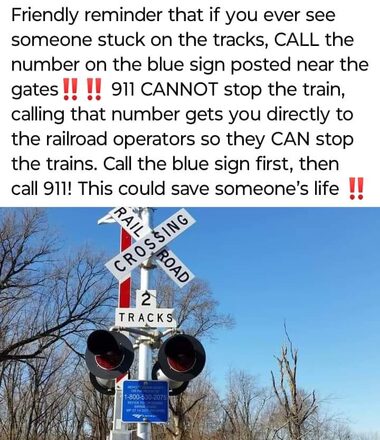
The old saying, A Picture is Worth a 1000 Words, communicates the truth in this instance.

Coffee Tracks and AMTRAK Support
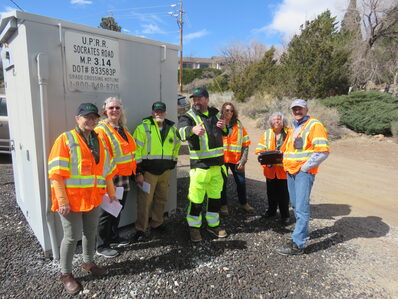
On Saturday, March 23, 2024 the Rail Auxiliary Team held its field training, affectionately known as Coffee Tracks at two locations in the Reno area. Our first stop was Crossing#833583P at Socrates Drive. While observing the crossing, we matched the current crossing inventory visible to the DOT Crossing Inventory Form and found that that were several discrepancies. We discussed how to recognize the crossing inventory, where to find the crossing inventory forms and how to report a discrepancy.
The app Railroad Crossing Locator (Apple / Google) was demonstrated by showing how to locate a current crossing near your location, how to see the Inventory Report and other pertinent information regarding the crossing.
We traveled a little further down the road to Crossing #833581B on Comstock Drive. Once again we looked at the crossing inventory and discovered one discrepancy, a missing an Advance Warning Sign known as a W10-1. This missing sign is the responsibility of the City/County, not the railroad.
There was a comparison made also with what Google Maps displayed at/near the crossing and what actually existed around the crossing. One concern noted was the construction going on extremely close to the tracks. This raised several questions. First, has the railroad been notified of this construction activity so close to their tracks and secondly, has the construction firm been educated on safety around railroad tracks.
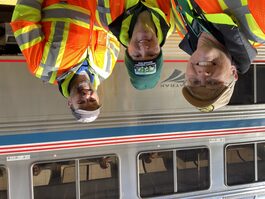
The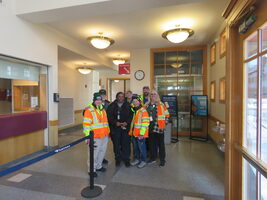 Washoe County Rail Auxiliary Team conducted its monthly support on Sunday, March 24, 2024 to the Reno AMTRAK station. The Team provided a station perimeter check, station entrance support and helped with the AMTRAK passengers as they debarked and embarked from their trip.
Washoe County Rail Auxiliary Team conducted its monthly support on Sunday, March 24, 2024 to the Reno AMTRAK station. The Team provided a station perimeter check, station entrance support and helped with the AMTRAK passengers as they debarked and embarked from their trip.
PRESS RELEASE
HELPING DURING THE WORST OF TIMES
The Community Emergency Response Team (CERT) is a group of volunteers who dedicate themselves to help the community during the worst of times such as wildfires, earthquakes, or floods. The CERT program offers a consistent, nationwide approach to volunteer training and organization that professional responders can rely on during disaster situations, allowing them to focus on more complex tasks.
Recently, me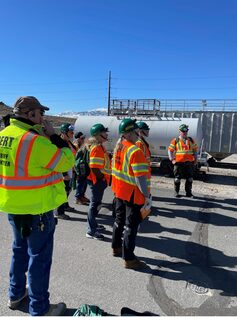 mbers of the Washoe County Sheriff’s CERT program participated in simulated emergency response situations designed to hone their skills in an emergency situation at the Regional Public Safety Training Center. Part of this training dealt with understanding the unique environment of the railroad infrastructure.
mbers of the Washoe County Sheriff’s CERT program participated in simulated emergency response situations designed to hone their skills in an emergency situation at the Regional Public Safety Training Center. Part of this training dealt with understanding the unique environment of the railroad infrastructure.
The Washoe County Sheriff's Office Rail Auxiliary Team (RAT Pack) discussed how to operate and stay safe around the railroad tracks. Topics included the Emergency Notification System, railroad mileposts and railcar identification. The RAT Pack also pointed out how local first responders will effectively work with the railroad’s HAZMAT team in the unlikely event of a derailment.
Helping their community in all situations, to include the railroad environment, is crucial for CERT to operate in a high stress environment to free up first responders to deal with the more complex situations.
If you are interested in joining the Washoe County CERT program or become a member of the Washoe County Sheriff's Rail Auxiliary Team contact Joe Olaciregui, CCP Coordinator at J[email protected] or (775) 325-6928.
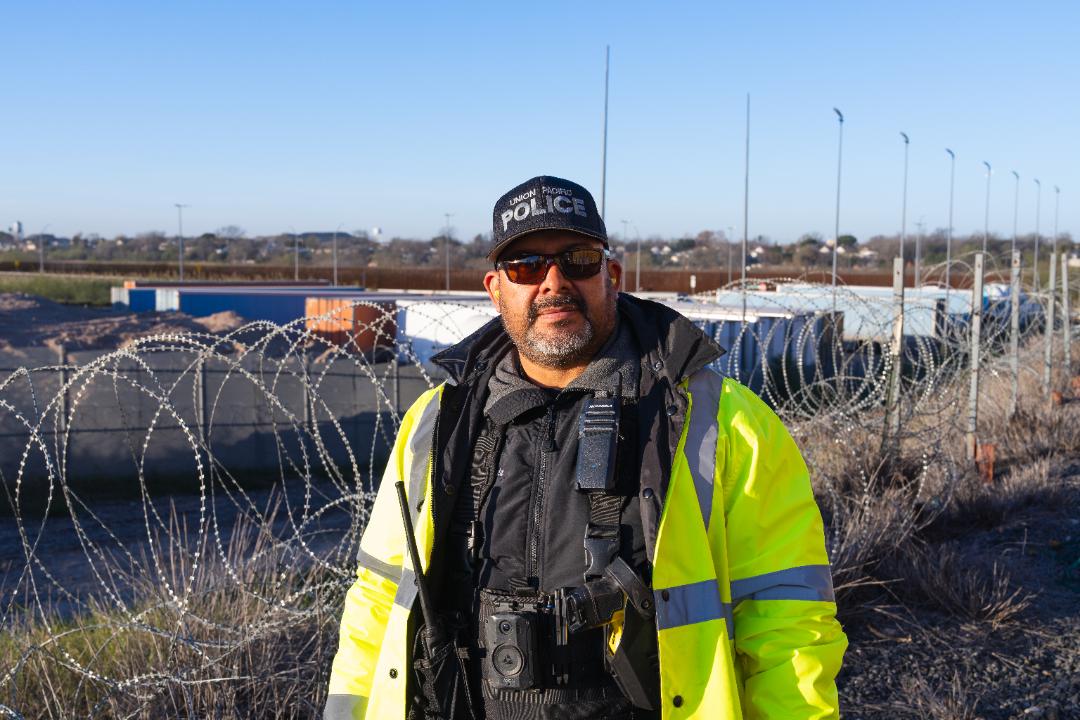
Union Pacific Senior Special Agent Danny Castaneda in Eagle Pass, Texas.
At the start of every workday – typically around 5 a.m. – Union Pacific Senior Special Agent Danny Castaneda packs up his gear and heads to work in Eagle Pass, Texas, with his partner, a K-9 named Saar, in tow.
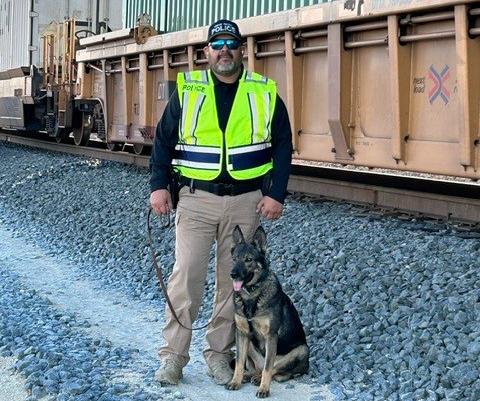
Castaneda and his K-9 partner, Saar.
Their mission every day is to help protect Union Pacific’s crucial rail network and customers’ goods traveling into the U.S. from Mexico.
The pair carefully inspects rail cars coming into the U.S., on the lookout for people, contraband and signs of missing goods.
“We walk the tracks, checking seals on containers and box cars,” Castaneda said. “It’s vital we try to catch as much as possible. Before I can even see something, Saar is already on alert, raising her head and leaning left and right as she picks up on the scent from the wind blowing in our direction. When she pulls harder, she’s on to something.”
Union Pacific serves six gateways into and out of Mexico, with the railroad investing billions annually to protect its rail network, including technology and resources to secure U.S. border crossings. Around 40% of all goods transported by Union Pacific originate or terminate outside of the U.S.
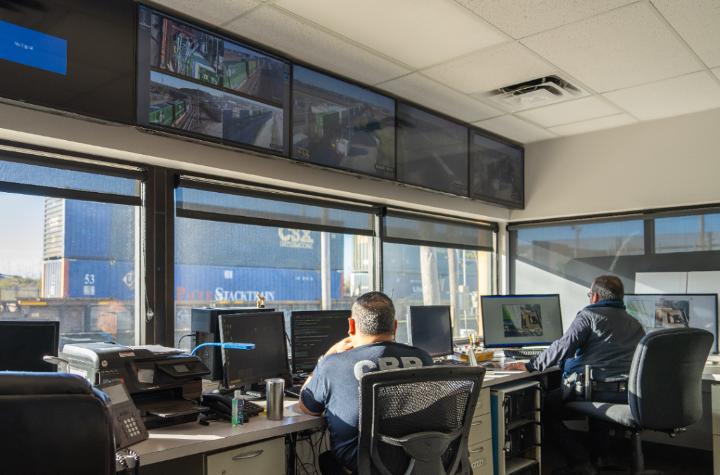
U.S. Customs & Border Protection employees inspect a Union Pacific intermodal train at the border.
Union Pacific uses an X-ray system to look for people and contraband as trains come into the U.S. across Union Pacific’s Eagle Pass railroad bridge above the Rio Grande River. Finding contraband before it makes its way into the country is critical to the safety and security of the railroad, its employees and the communities it serves.
“If the system detects a void or anomaly in a rail car, I’m alerted and will do a physical inspection,” Castaneda said. “Recently, we detected an intermodal container was missing about 10 catalytic converters. Discovering cases of theft at the border helps protect both the customer and Union Pacific.”
The railroad’s collaboration with the U.S. Customs & Border Protection and Texas Department of Public Safety is vital, Castaneda said.
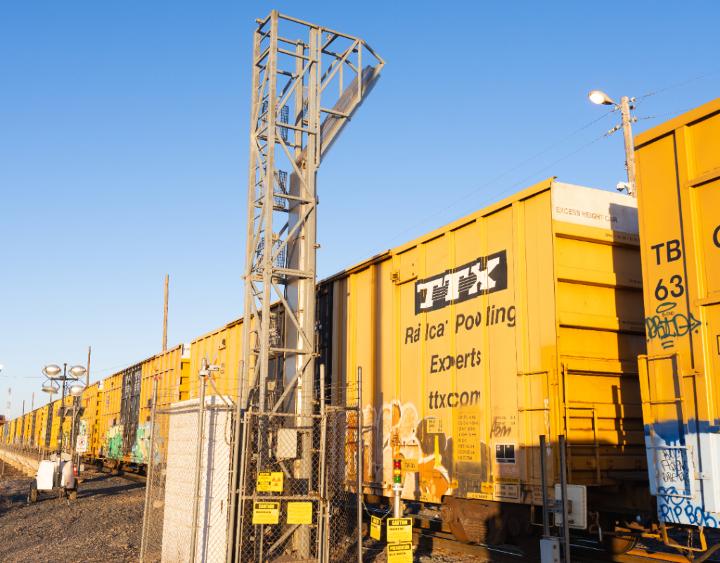
Security equipment and the area used to inspect trains coming across the border.
“Their presence is crucial to what we do on a daily basis,” he said. “They are consistently patrolling the tracks and helping us with anything we need.”
Castaneda, who grew up in Eagle Pass and became interested in law enforcement at a young age, knows the area like the back of his hand. Before joining Union Pacific eight years ago, he served as an Eagle Pass police officer, working the last several years on the Drug Enforcement Administration Narcotics Task Force. A friend referred him to Union Pacific.
“I like what the railroad is all about,” he said. “Everyone works well with each other and cooperates to get the job done. Everything runs very smoothly on our end.”
Did You Know: The railroad police force dates back to the mid-1800s, when the number of U.S. Marshals was insufficient to police America’s growing rail network. Railroad police are certified state law enforcement officers with investigative and arrest powers both on and off railroad property in most states. These agents investigate crimes involving trespassing on railroad rights of way, theft of railroad property and threats of terrorism.
Nevada's Retired First Responders and Military Veterans Pioneering Railroad Public Safety and the See Something Say Something Campaign with the RAT PACK:
[Reno, NV, October 18, 2023] — A remarkable and innovative initiative is transforming Nevada's rail landscape as retired first responders and veterans unite to safeguard the state's railroads. These seasoned professionals, with a wealth of experience in dedicated service, public safety and emergency response, are taking on a novel and indispensable role. Under the auspices of the Washoe County Sheriff Office's Community Emergency Response Team (CERT), the Rail Auxiliary Team, affectionately known as the RAT PACK, is emerging as a trailblazing force in railway public safety and their ability to report suspicious activity to the appropriate agency with accurate and timely information.
The RAT PACK is laser-focused on enhancing the safety, security and integrity of the railroads in Washoe and Storey Counties in Nevada. Leveraging the extensive backgrounds and expertise of retired first responders, they bring an unparalleled level of knowledge and dedication to the task.
However, their role extends beyond physical monitoring. RAT PACK members actively contribute to public safety measures through education and the implementation of reporting methods aimed at reducing or eliminating train/trespasser incidents. They serve as a vital bridge between the community and law enforcement, positioning the counties proactive approach against potential rail public safety issues as well as suspicious activities on or near the tracks.
Trespasser deaths and suicides by train not only devastate the trespassers' families but also have traumatic effects on train engineers, conductors, first responders and witnesses who must deal with the aftermath. Nvrailaware.org , the State suicide prevention agency, along with railroads across the United States and Europe, are working diligently to reduce trespasser deaths, suicides, and suicide attempts through awareness campaigns, employee education, interventions, and mental health promotion.
The COVID-19 pandemic has had a profound impact on mental health, resulting in a significant increase in attempted suicides, suicides, and mental illness across all demographics, affecting the rail and transit industry as well. NVrailaware.org is committed to fostering collaboration among industry stakeholders to tackle suicide prevention, promote mental health resources, and implement mitigation initiatives.
To prepare these professionals for their pivotal roles, retired first responders undergo comprehensive training modules tailored to the intricacies of railroad public safety and what could be considered suspicious activity supporting the See Something Say Something campaign. . This comprehensive curriculum covers a wide range of topics, including general rail safety, basic railroading, and the legal aspects of railroad private property. An innovative aspect of the training is the ability of this group to effectively, efficiently and accurately report any rail public safety issue to the appropriate agency for action.
In addition to rigorous on-site training, RAT PACK members are required to receive 8 hours of rail-specific training as well as monthly on-line or face to face training. This resource, delivered through computer-based instruction and streaming video, offers a flexible and convenient learning model accommodating individual paces and preferences.
The RAT PACK's innovative approach not only equips retired veterans and first responders with new skills but also presents a practical, comprehensive solution to maintaining the safety of Nevada's railroads. These dedicated professionals continue to serve their communities, collaborating closely with railroad asset protection and local law enforcement to preserve the integrity of vital rail infrastructure.
The concept of harnessing the experience of retired first responders for community betterment is not entirely new, but its innovative application in rail public safety monitoring is a game-changer. This initiative enhances rail system public safety while allowing these veterans to extend their service, making their retirement years meaningful and productive.
The potential for broader application of this model is substantial, offering a blueprint for replication in other states and industries. It underscores the power of experience and knowledge transfer for community well-being and safety enhancement. As the RAT PACK's unwavering commitment to safety and security and service garners recognition, Nevada's retired first responders and military veterans are exemplifying that retirement years can be a testament to continued service, further enhancing the safety of the state's railroads and underscoring their dedication to the community.
For more information and to learn about this groundbreaking initiative, please visit:
RAT PACK Information
nvrailaware.org.
About Nevada Rail Aware :
Nvrailware is a pioneering organization dedicated to railway safety, security and the prevention of trespasser incidents and suicides on railroad tracks. Recognized as one of the nation's community-based suicide prevention organizations, we tirelessly promote awareness, educate the community, and foster partnerships to enhance rail transportation safety.
Do you know what to do if you see someone walking on railroad tracks with a train barreling down in the distance? Or if your car gets stuck on the tracks?
The Rail Auxiliary Team in Washoe County, Nevada, educates the public on such topics and monitors local railroads to report people who might be in danger on or near train tracks. They also ensure railroad crossings are safe. Team members also are trained by the Nevada Office of Suicide Prevention to deal with potentially suicidal individuals.
The team, informally known as the “Rat Pack,” has more than 120 volunteers, mostly retired veterans, said Richard Gent, a retired naval officer from Fallon, Nevada, who created the team about eight years ago.![]()
In the United States, trains collide every three hours with either vehicles or pedestrians, Gent said.
“What we are trying to accomplish here is keep people safe and keep trained eyes near the railroad infrastructure,” he said. “Our guys and gals are out there looking at the railroad tracks, focusing on safety.”
Gent devised a curriculum of eight hours of classroom instruction for Rail Auxiliary Team volunteers. That includes basic railroading — such as how to identify different trains and box cars — reporting procedures, awareness of potential criminal activity and terrorist threats, and suicide awareness. Once part of the team, volunteers complete ongoing monthly classroom and online training, as well as field and tabletop exercise
Railroad tracks, and the land immediately adjacent to them, belong to railroad companies like Norfolk Southern Railway, BSN Santa Fe Railway, Amtrak and more. Rail Auxiliary Team volunteers wear orange reflective vests and are careful not to go onto railroad property, which constitutes trespassing, Gent said.
“The railroad has color codes for their personnel, and an orange vest signifies an individual on the ground,” he said. “A locomotive engineer will recognize it.”
Volunteers don’t operate in shifts, but rather check out railroads on their own time, whenever they are out and about, Gent said.
“What we say is, ‘Hey, if you’re going to Walmart, take a little side trip and go down by the railroad tracks and take a look,’” he said. “We found out it’s quite effective.”
Team members also use their own drones to survey railroad tracks from above, he said.
When team members spot something off, they alert the owners of the railroad, who in turn immediately contact train engineers, as well as law enforcement, for a quick response. The team calls in three to four reportable events per month, more in spring and summer, along the 50 or so miles of tracks in Washoe County, Gent said.
That has saved lives, such as last summer, when a team member reported a family walking along railroad tracks near the Cherokee River. The railroad company alerted the incoming train engineer who sounded the horn to prompt the family to get off the tracks, Gent said. Team members usually refrain from directly addressing trespassing individuals in order to avoid confrontations, he said.

Courtesy photo
Reporting malfunctions at railroad crossings, such as non-working lights, is another task the volunteers take on. In fact, anyone can do that by calling the toll-free phone number listed on blue emergency notification system signs placed at crossings, he said.
Additionally, the Rat Pack offers railroad education to the public, such as school bus drivers, emergency responders and others. Volunteer Art O’Connor, a veteran who lives in Reno, Nevada, said he especially enjoys giving lectures about railroad safety, such as what to do when a vehicle gets stuck on the tracks.
“(911 operators) have no clue how to stop that train, but if you call the 1-800 number on the emergency notification system sign, they will immediately stop the train and you will not become a statistic,” O’Connor said.
Volunteers also know about “hot spots,” such as railroad bridges that people like to cross on foot despite the danger of incoming trains, O’ Connor said. People should always use pedestrian bridges, no matter how inconvenient, he said.
O’Connor’s interest in railroads dates back to his youth, when he traveled by train from his family’s home in South Carolina to boarding school in Massachusetts. Volunteering with the Rail Auxiliary Team is all about giving back, he said.
“It’s rewarding,” he said.
Gent also has loved trains since childhood. He used to watch VHS tapes of moving trains while stationed in an aircraft carrier in the South China Sea, and now has a railroad caboose in his yard that he uses as an office, he said.
“It’s a strange disease,” he said, chuckling. “I’ve talked to other individuals that like trains, and it’s just a passion.”
When he approached the Washoe County Sheriff’s office eight years ago with his idea of creating the team, the reaction was immediately positive, Gent said. Now, he’d like to expand the Rail Auxiliary Team program throughout Nevada and across the country.
Joe Olaciregui, Citizen Corps Programs coordinator for the Washoe County Sheriff’s office, endorsed that.
“We are trying to grow the program so we can start getting it out to other counties and nationwide. It’s good for any place that has rail traffic that goes through it,” he said. “The bottom line is responder safety and life safety.”
Rail Auxiliary Team volunteers first go through the community emergency response team academy, of which they are an integral part, Olaciregui said. “That team is awesome,” he said. “They are absolutely killing it.”
For more information, visit the Washoe Sheriff’s Office website, Rail Auxiliary Team (RAT Pack) (washoesheriff.com)
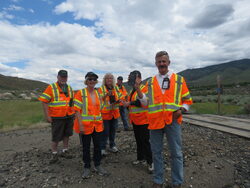
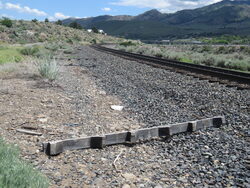
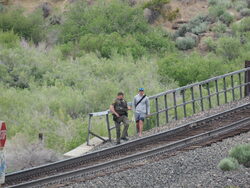
On Friday afternoon June 23, 2023 our RAT pack initially met in Verdi at the local fishing hotspot. Upon arriving, a RAT member noticed a fisherman walking along the tracks to get to his favorite fishing hole. A call to RMCC notified the railroad of a trespasser. A short time later, two RATS witnessed another fisherman walking the tracks to get down to the Truckee River. A second call to RMCC was made, notifying them once again of a trespasser. This time the railroad also notified the Washoe County Sheriff.
About 40 minutes after the call was made, the sheriff arrived, collected information from us and proceeded down to the river. The sheriff was able to talk with the fisherman, get him out of the river and then educate him on what NO TRESPASSING signs mean. This is the first time that we have actually been around when a sheriff arrives and is actually able to talk with the trespasser. We were also able to educate the sheriff about our responsibilities as RAT members and what our protocol is when we see a trespasser on railroad property.
As we were looking around, we noticed a bunch of debris along the tracks that looks to have come off a train. It was not affecting train traffic, so no report was made.
Two people educated about the law and the dangers of trespassing on or near railroad tracks and bridges - that's success!

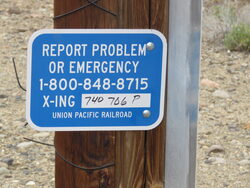
Our RAT pack then proceeded into town and met at the Bridge Street crossing. We surveyed the area, checked that the crossing inventory was in place and looked around to evaluate any potential crossing issues with trespassers. After this, we headed to a private crossing that most RATs had not been to before. It was noted that this private crossing and road is often used by fishermen to also get to the Truckee River. All looked good at this crossing, so we called it a day and ended our Coffee Tracks field trip.
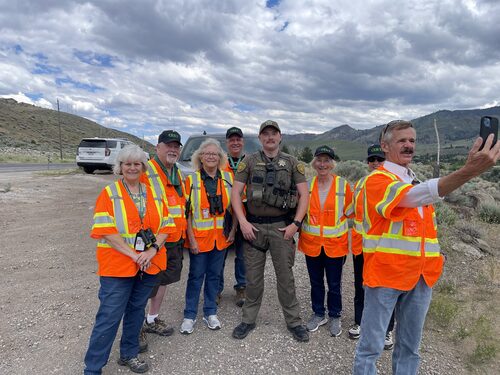
We would like to thank the Washoe County Sheriff's office for their help in keeping people safe around railroad property. A BIG thank you from the RAT pack!
And ALWAYS remember . . .
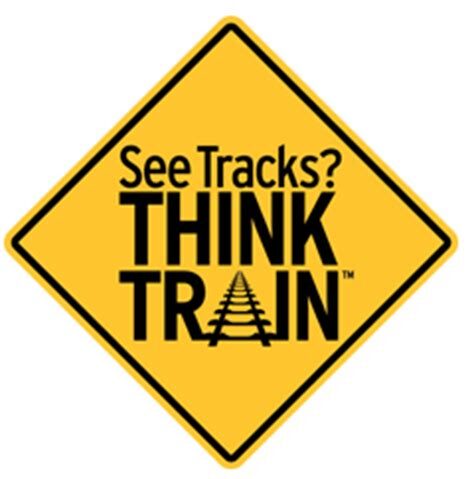
What does a NO TRESPASSING Sign Mean?
Railroad tracks and crossings are very dangerous places if warnings are not heeded. Railroad companies spend time and money to make a person’s time at a crossing or around trains as safe as possible. Warning signs, flashing lights, crossing gates, bells, pavement markings, etc. along with NO TRESPASSING signs are put into place for a reason – to keep you physically safe and to keep train crews from having to deal with the aftermath of a tragic accident that was not their fault. (Remember, trains can’t steer and it often takes them more than one mile to stop.)
So, what does a NO TRESPASSING sign mean?
Choose the correct answer:
A. If I cannot see a train, then I can walk on or along the tracks.
B. Those signs are for other people, not me.
C. I can get out of the way of a train before it gets to me, so I can go on the tracks anyway.
D. Trains hardly ever come on these tracks – there won’t be one now.
E. Stay off tracks and bridges, out of tunnels and out of the railroad right-of-way,
which extends approximately 50 feet on both sides of the track.
Unfortunately, most people may agree that E is correct, (Stay off tracks and bridges, out of tunnels and out of the railroad right-of-way, which extends approximately 50 feet on both sides of the track.), but they act like A, B, C and D are correct.
What is your response to a NO TRESPASSING sign? Do your actions look like answer A, B, C or D above? Or do you obey the NO TRESPASSING sign?
In Verdi, NV there is a location that we call our “fishing hotspot”. This is a narrow train bridge across the Truckee River in which fishermen consistently ignore the very visible NO TRESPASSING sign at each end of the bridge. Why? Because it is a shortcut to their favorite fishing hole. A shortcut I say, because there is a correct way to cross the river that is just a few steps longer. Is the convenience of a shortcut worth the risk of getting hit by a train? NO!
Remember, your life is worth obeying any railroad warning signs!

On Saturday morning March 18, 2023 our RAT pack met at crossing 833573J .
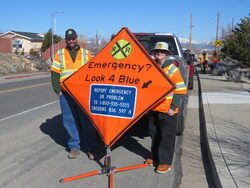
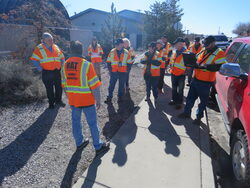
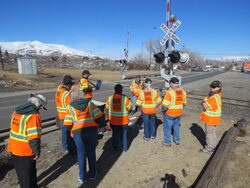
In preparation for our RAT field exercise, RATs always set up an orange traffic warning sign to warn drivers that people are present in the area and to also educate the public. This sign is a reminder that if you ever see a vehicle stuck on the tracks, look for the blue Emergency Notification System sign at the crossing and call that phone number first, before calling 911, and tell them about the vehicle on the tracks.
Anytime we are meeting at a crossing, we do an inventory of the equipment We check the following things:
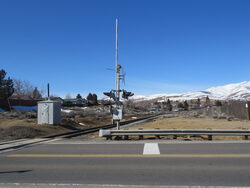
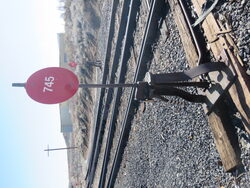
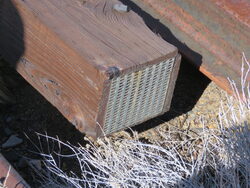
Crossing 833573J and the bungalow associated with that crossing are at a very busy crossing and often drivers get impatient and go around the crossing gates when they are down. Don't ever go around gates when they are down! When you see gates in the down position, there is a train nearby.
We talked about switches and the requirement that they are to always be locked.
While checking out the crossing, we came across a pile of rails and ties - some new and some used. A fellow RAT pointed out that Timber Nail Plates are used to strengthen the ends of railroad ties, reducing their tendency to split when spikes are driven into them.
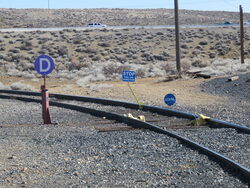
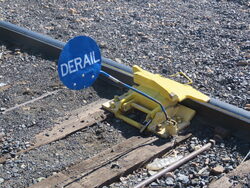
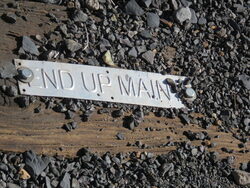
The blue derail indicators on the track warn an approaching train or railcar that if they proceed to this point, the train/railcar will be derailed. The derail device is used to protect people or trains further down the track. Derail devices are to be locked at all times.
The metal stamped sign along the tracks indicates where the railroad's responsibility for maintaining the track ends and the company that the track is going to is responsible for the maintenance on their part of the track. In this case, Union Pacific's track ended at this spur and Ameri Gas become responsible for their part of the track.
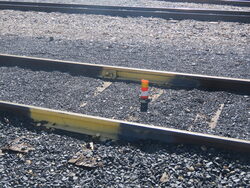
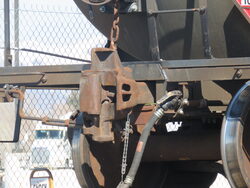
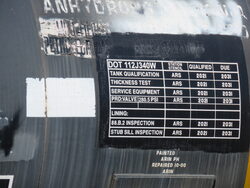
The yellow paint and orange cone indicate the point on the track that the train cannot go past, or it will trigger the lights, gates and bells at the crossing in front of it.
We learned that tank cars carrying hazardous materials have a special coupler known as a double shelf coupler. While the coupler is designed to not uncouple, the main reason for the "shelf on the top and bottom" is to keep one tank car from riding up and puncturing the end of another tank car.
Tank cars have many requirements specified by the Department of Transportation. This panel identifies the tank car as a DOT 112 car. A DOT-112 pressurized tank car has additional safety features than what is required on DOT-111 class non-pressurized tank cars. This 33,700 gallon tank car is built to meet DOT 112J340W specifications and to operate at 263,000 lbs gross rail load for the transportation of liquefied petroleum gas (LPG).
We love our Coffee Tracks field training and yes, we do sometimes even have coffee!
Remember . . .
